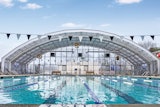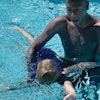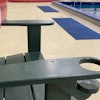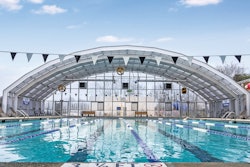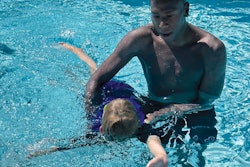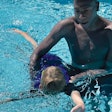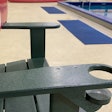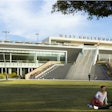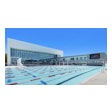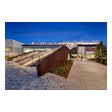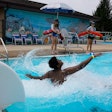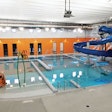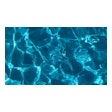![Mitch Park YMCA, Edmond, Okla. [Photo by Charles Davis Smith, courtesy of Brinkley Sargent Wiginton Architects]](https://img.athleticbusiness.com/files/base/abmedia/all/image/2016/06/ab.spotlight516_feat.png?auto=format%2Ccompress&q=70&w=400)
This article appeared in the May issue of Athletic Business. Athletic Business is a free magazine for professionals in the athletic, fitness and recreation industry. Click here to subscribe.
Let's assume that your competition pool is no shorter than 25 yards, 25 meters or 50 meters with touchpads installed. No touchpads? You're allowed to add an extra 0.03 of a yard or meter, respectively, to the minimum length, per FINA rules. Let's also assume that you have 16 to 20 feet of deck width to accommodate not only spectators, but dozens of idle swimmers and roaming meet officials, who combined likely outnumber the spectators. Sufficient locker rooms, storage rooms and auxiliary spaces to accommodate team training and massage are a plus (and required if you plan to host an NCAA event).
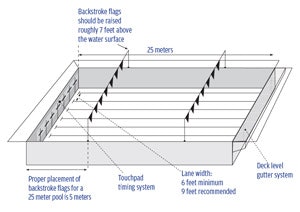 Click to enlarge
Click to enlarge
The fastest pools will be equipped with rim-flow or cantilever gutter systems that swallow water turbulence, lanes that will be on the wider end of the typical 7-to-9-foot range and depths that range from 7 or 8 feet (if water polo is played in the pool) to the ideal 2 to 3 meters for swimming competition.
These are all design-phase considerations, but they're only the beginning. Once a pool is built, it needs to be accessorized for competition. Here's a quick look at a few of the pieces of equipment — some having evolved to their current state of the art only within the past few years — that make hosting a meet possible.
![[Photo by Shutterstock]](https://img.athleticbusiness.com/files/base/abmedia/all/image/2016/06/ab.SP1_300x199.png?auto=format%2Ccompress&fit=max&q=70&w=400) [Photo by Shutterstock]
[Photo by Shutterstock]
STARTING BLOCKS
What better place to start than the equipment swimmers use to launch themselves into the water? "There are only a couple things that the athlete touches, and the starting block is one of them," says Steve Crocker, a principal at Water Technology Inc. "So that's one thing the coach will often feel passionate about."
There are two basic types of starting blocks: those anchored to the pool deck on posts slipped into deck sleeves and those that employ something resembling a broader four-sided base. The latter type requires tools to install and remove and is always at the fixed height above the water surface (typically 29½ inches). Posted starting blocks offer the added flexibility of height adjustment in situations in which a pool is used both lengthwise and widthwise to accommodate different course distances. In the event the pool's sides and ends have different deck heights, anchor sleeves can be set at appropriate depths to compensate, keeping the starting block's platform at the desired height in relation to the water surface.
Modern starting blocks feature larger top surfaces than ever before — 32 inches in length replacing the previous 24-inch standard — allowing swimmers to assume a variety of starting positions. Moreover, most starting blocks include an adjustable wedge at the rear of the top surface, already tilted toward the water as much as 10 degrees, with the wedge tilting up to 30 additional degrees to act like a track-style starting block in terms of secure footing at launch. Tops featuring these wedges, which can be retrofitted to most existing blocks, make a side-mount option preferable for swimmers. Starting blocks can also come with side handles, which some swimmers choose to grab for extra launch leverage, and the best blocks offer a non-slip surface that is not too abrasive.
Relay judging platforms can be mounted to the top of starting blocks to help remove the human element from the process of judging relay exchanges. A built-in sensor syncs with the touchpad in the water, ensuring that the next swimmer in the relay doesn't leave the block before the previous swimmer touches the wall. These are not foolproof, however. Because swimmers may stand toward the back of the starting block for a step start or shift their weight in anticipation of their relay leg, a false departure reading can occur. For this reason, confirmation in the form of onsite video review is recommended.
Perhaps most important, starting blocks should be solid, with no movement or "play" exhibited upon takeoff. A single-post starting block allows for tighter tolerances in relation to its single deck sleeve, making dual-post blocks, which add the variable of lining up two posts into deck sleeves, increasingly obsolete.
![[Photo courtesy of Colorado Time Systems]](https://img.athleticbusiness.com/files/base/abmedia/all/image/2016/06/ab.SP2_300x200.png?auto=format%2Ccompress&fit=max&q=70&w=400) [Photo courtesy of Colorado Time Systems]
[Photo courtesy of Colorado Time Systems]
BACKSTROKE WEDGE
To avoid foot slippage during starts of the backstroke, the only event that begins in the water, pools may employ backstroke wedges — strips of non-slip material that dangle below the water surface on straps for the purpose of offering more secure footing than a pool wall or touchpad. These wedges must then be retracted from the water after the event start, either manually by a lane official or mechanically.
BACKSTROKE FLAGS
A simple item but one that can't be overlooked, backstroke flags span portable stanchions placed on opposite sides of the pool — 5 yards (or 5 meters, depending on the type of course) from the end wall and roughly 7 feet above the water surface, allowing swimmers to gauge when they should initiate their turn. "It's critical," Crocker says. "You couldn't swim a backstroke race without them."
Some meets will have officials remove these flags during non-backstroke events, since they can represent a visual impairment.
![Platte County Community Center North, Platte City, Mo. [Photo by Manginelli Productions]](https://img.athleticbusiness.com/files/base/abmedia/all/image/2016/06/ab.SP3_300x200.png?auto=format%2Ccompress&fit=max&q=70&w=400) Platte County Community Center North, Platte City, Mo. [Photo by Manginelli Productions]
Platte County Community Center North, Platte City, Mo. [Photo by Manginelli Productions]
LANE LINES
Lane lines not only separate swimmers, they also help quell a swimmer's wake from one lane to the next.
Dozens of plastic discs comprise each lane line, and these discs can come in different sizes. The larger the diameter, the better the line can control each swimmer's wake and the collective chop that can otherwise result, disrupting swimmers' rhythm and breathing. Keep in mind, however, that a 6-inch diameter will consume approximately twice as much space on a storage reel as a 4-inch-diameter lane line. Some competitions even allow two lines to separate lanes in the interest of wake containment.
![[Photo courtesy of Colorado Time System]](https://img.athleticbusiness.com/files/base/abmedia/all/image/2016/06/ab.SP4_300x200.png?auto=format%2Ccompress&fit=max&q=70&w=400) [Photo courtesy of Colorado Time System]
[Photo courtesy of Colorado Time System]
TOUCHPAD TIMING SYSTEMS
Most meets, and invariably those recording qualifying times, employ a touchpad timing system. "It's about a three-tenths-of-a-second difference, on the average, between a touch-pad time and a stopwatch time, just because people's reaction times are slower," Crocker says. "It's not a legitimate competition if you don't have touchpads."
Ideally, a pool is equipped with touchpad technology at its inception, allowing for conduit to be placed beneath the pool deck. "Surprisingly, everything is still wired," says Crocker. "It's hard to believe in 2016 that all of this stuff is not wireless, but there's a concern among the manufacturers that results could be hacked."
![[Photo courtesy of College of San Mateo]](https://img.athleticbusiness.com/files/base/abmedia/all/image/2016/06/ab.SP5_300x200.png?auto=format%2Ccompress&fit=max&q=70&w=400) [Photo courtesy of College of San Mateo]
[Photo courtesy of College of San Mateo]
SCOREBOARDS
Scoreboards should be able to display the athletes' names, representative schools and race results for the event at hand, plus running team scores — even if it takes separate scoreboards to display the information, according to the NCAA. Video replay is a plus.
"You'd prefer to have a modern scoreboard with video capabilities, even if it's not TV quality — something that allows for advertisements and alteration for a six-lane versus eight-lane versus 10-lane event, swimming versus water polo or diving," says Justin Caron, principal and vice president at Aquatic Design Group. "You can custom program it so that it really fits the competition."
These have come down in price significantly, Caron adds. "You can get a video board now for what you paid for an LED scoreboard just five years ago."
![Waukesha South High School, Waukesha, Wis. [Photo by Peter Zuga]](https://img.athleticbusiness.com/files/base/abmedia/all/image/2016/06/ab.SP6_300x200.png?auto=format%2Ccompress&fit=max&q=70&w=400) Waukesha South High School, Waukesha, Wis. [Photo by Peter Zuga]
Waukesha South High School, Waukesha, Wis. [Photo by Peter Zuga]
BULKHEADS
Bulkheads require a bigger investment than most pool amenities, with a price range solidly within six figures, but the value they bring to a facility is undeniable. For example, while competitive swimmers don't favor a 4-foot water depth, it is essential for learn-to-swim programs. In pools long enough (referred to as "stretch pools"), bulkheads allow for the separation of deep and shallow ends, or the efficient, simultaneous staging of swimming and diving.
"They're so expensive that you don't see a lot of them, but programmatically they're incredible," Caron says. "They allow a single venue to host any style of meet — 25 yards, 25 meters, 50 meters. You can separate the pool into two 25-yard courses or two 25-meter courses, depending on how long it is. You can do water polo and swimming simultaneously, diving and swimming simultaneously."
There are myriad additional items recommended, if not required, when hosting a meet: a public-address system; lifeguard equipment; a first-aid kit; lap indicators; stopwatches, clipboards and pencils (as backup in the event of a timing system failure); and a printer and paper for heat sheets and results.
More from AB: Product Spotlight: Aquatic Components
At most levels of competition, the goal shouldn't necessarily be to create the fastest pool the athletes are likely to see all season. After all, at any given high school dual meet or club invitational, participating athletes are all dealing with the same pool conditions in a level "playing field," Caron says. Rather, competitive swimmers want to post their fastest times when it counts — at season's end. Everything they do — from tapering their training to shaving their bodies — is focused on peaking at the desired time, perhaps a conference championship meet or a state final. Swimming the bulk of the year in a pool that's on the choppy side can only help when competitors dive into waters of facilities designed and equipped to be as fast as possible.
![Hamilton Southeastern Natatorium, Canby, Ore. [Photo courtesy of S.R. Smith]](https://img.athleticbusiness.com/files/base/abmedia/all/image/2016/06/ab.SP7_300x200.png?auto=format%2Ccompress&fit=max&q=70&w=400) Hamilton Southeastern Natatorium, Canby, Ore. [Photo courtesy of S.R. Smith]
Hamilton Southeastern Natatorium, Canby, Ore. [Photo courtesy of S.R. Smith]
"I'm a big believer that not every pool needs to be designed for a championship meet," says Crocker. "For a typical high school dual meet there's no reason that the pool needs to be designed for high-end competition." Adds Caron, "Some coaches will tell you they want their athletes to learn to go through some adversity in training so they appreciate it in the meets, and it's just that little extra mental edge."
If you're not sure what equipment is best for your competition pool, ask a consultant. "Just through trial-and-error experience, we've found things that work better," Caron says. "It's always problematic to make a bold statement like you have to have this starting block or lane line. Different coaches, different facilities have different preferences, different experiences. There are certainly levels that we design to. Fortunately, there are multiple manufacturers who can meet our qualifications."
"Most of the time, we like to list approximately three manufacturers," Crocker says. "That allows the contractor to use their preferred supplier, and many times it brings the cost of the facility down by doing that."
This article originally appeared in the May 2016 issue of Athletic Business with the title "Equipping a first-rate competition pool"










